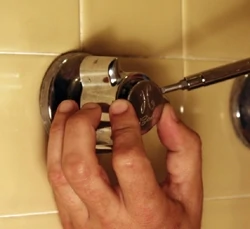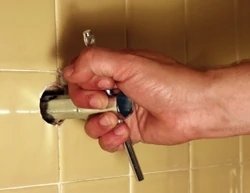By Matt Weber
Don’t blame the showerhead for a leaky spout. The problem originates in the valves behind the shower handles.
When a tub or shower faucet leaks, don’t scowl at the spout. That’s like blaming the messenger for bad news. The trouble lies behind the handles, which turn valves that govern the flow of water to the spout. It’s important to fix these valves as soon as possible because, aside from the irritating drip-drip-drip, a leaky shower faucet can waste a small pond of water every day. The repair is fairly simple, but you’ll need a special set of deep-socket wrenches to get the job done. Don’t fret over the price, though. The wrenches are available at most hardware stores, and Harbor Freight sells a set for only $9.99—compare that to the cost of plumber.
Step-by-step Repair
First and foremost, shut off the water supply to the faucet before disassembling the handles.

Modern compression faucets generally have rubber seat washers that seal water from the spout, and the washers can deteriorate over time resulting in a leak. To get to the washers, you must remove the handles which are usually fastened with a threaded retaining nut hidden behind a decorative cap.


Begin by prying off the cap with a screwdriver. (In some cases these caps are threaded.) Then unscrew the nut to pull off the handle.
Next, remove the escutcheon. Escutcheons are often held with a retaining nut, but if not then the escutcheon is threaded over the valve stems. If this is the case, unscrew the entire escutcheon as one piece. If it won’t release, check to see if it’s caulked to the wall, and cut the caulk. A strap wrench may help encourage a stubborn one to turn.

Bath and shower faucets have the valves mounted deeply behind the wall. A box-end wrench won’t usually reach the bonnet nuts that hold them in place, and a standard socket won’t work because the center stem interferes with its reach—thus the need for a special deep socket.


Thread the socket over the stem and secure it tightly over the bonnet nut. Unscrew and remove. Pull the stem from the wall to expose the seat washer and screw. Remove the worn seat washer and replace with a new one, coating it with heat-proof faucet grease. Make sure to use the correct size and shape of seat washer and press it firmly into the stem’s retainer. If the stem is in good shape, you’re ready to reassemble the shower handles and test your faucet.

In some cases, the metal stems may be worn out and require replacement. The valve stems in our project were corroded and pitted around the washer’s retainer, contributing to the leak problem. We replaced both stems entirely, which ran roughly $12.50 each at the hardware store. They slip right into the pipes just like the old ones that we pulled out. (Be sure to use the faucet grease.)


Note: When purchasing the stems, take notice of the stem’s model numbers which are typically labeled with either H or C, indicating hot or cold. These indications determine the direction of handle rotation. You will need one of each and be sure to keep them straight during installation.


Handy Tools for the DIY Plumber
Shower Valve Socket Wrench Set. A shower-valve set provides the super-deep wrenches needed to remove tub and shower valves. The Pittsburgh set available at Harbor Freight is made of zinc-plated steel and comes with a chrome-plated turning bar. The wrenches are each double-sided, accommodating the 10 standard sizes of plumbing fasteners to make virtually any residential shower or bath valve repair. (www.harborfreight.com)
Strap Wrench. A strap wrench wraps a rubber strap snugly around objects of any shape to tighten or loosen them without damaging the surface. They’re great tools for a wide range of jobs, from unscrewing stuck plumbing fixtures to removing slippery oil filters. The two-sided Pittsburgh Rubber Strap Wrench Set contains two wrenches, large and small. The large wrench has a 24-by-3/4-in. strap and grips items up to 6-in. diameter. The smaller wrench has a 20-by-1/2-in. strap and grips items up to 4-in. diameter.
Quick-release Pipe Cutter. Pipe cutters can be used to cut copper tubing sizes 3/16 to 1-1/4 inch. The tool cuts pipe with a sharp wheel; just keep tightening its cutting depth with the handle’s knob as you rotate it around a pipe until you cut through the pipe wall. Pipe cutters create a smooth, even cut that is ready to form a joint. The Ridgid pipe cutter shown has a quick-release handle for fast adjustments without all the twisting and turning. It also includes a replacement wheel stored inside the handle. This type of plumbing tool cuts all types of copper pipe including L, M and K copper. (www.ridgid.com)
Faucet & Sink Installer. The Ridgid Faucet and Sink Installer (Model No. 2006) hit the market roughly four years ago, and over the years it’s become the EHT staff’s go-to tool for those under-the-sink plumbing jobs that require a number of different wrenches. This multipurpose device can fasten and remove plastic basin nuts, supply line nuts, plus 7/8- and 1-in. hex nuts. It also features two aluminum inserts; one for turning valve-stop handles, and one for holding strainer baskets in place. The tool’s multi-functionality eliminates many of those back-cracking trips between the toolbox and your temporary home beneath the sink. The tool’s oblong design also makes it ideal for hard-to-reach applications where clearance for a standard wrench handle is restricted. Highly recommended for the DIY plumber as well as the pro. (www.ridgid.com)
Sani Seal Toilet Gasket. For toilet installation, the Sani Seal toilet gasket eliminates the mess and guesswork of traditional wax gaskets. It has a unique shape that holds flange bolts upright and keeps the gasket in place for a quick, clean and easy toilet placement. The Sani Seal provides a 100-percent seal on all flanges, from cast iron or 4-in. PVC to less than 3 inches. It even works on flanges with inside shelves and off-set outlets. Visit www.sanisealgasket.com.
Other Bathroom Related Articles








